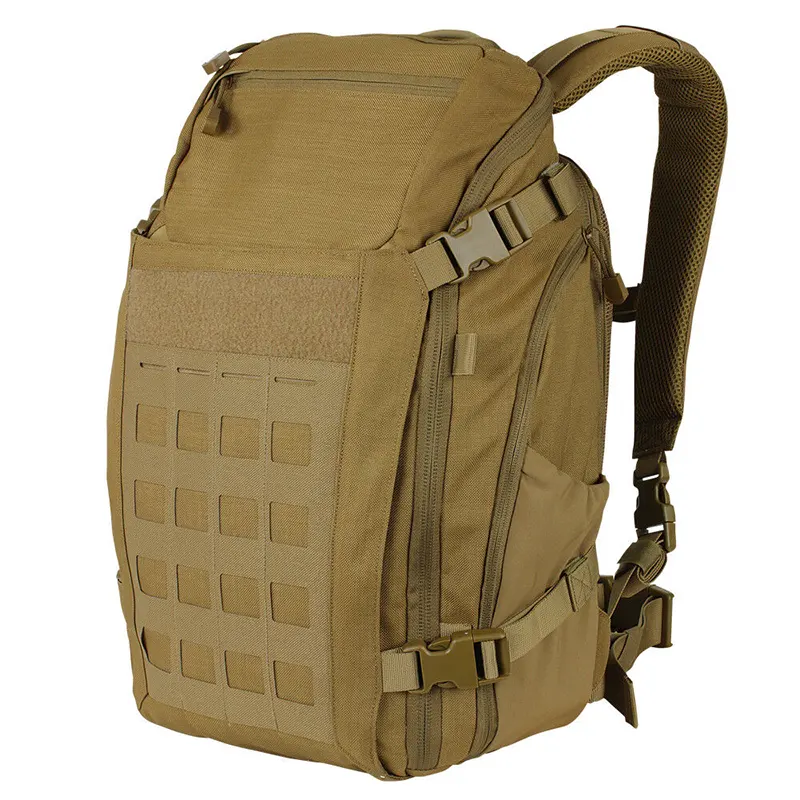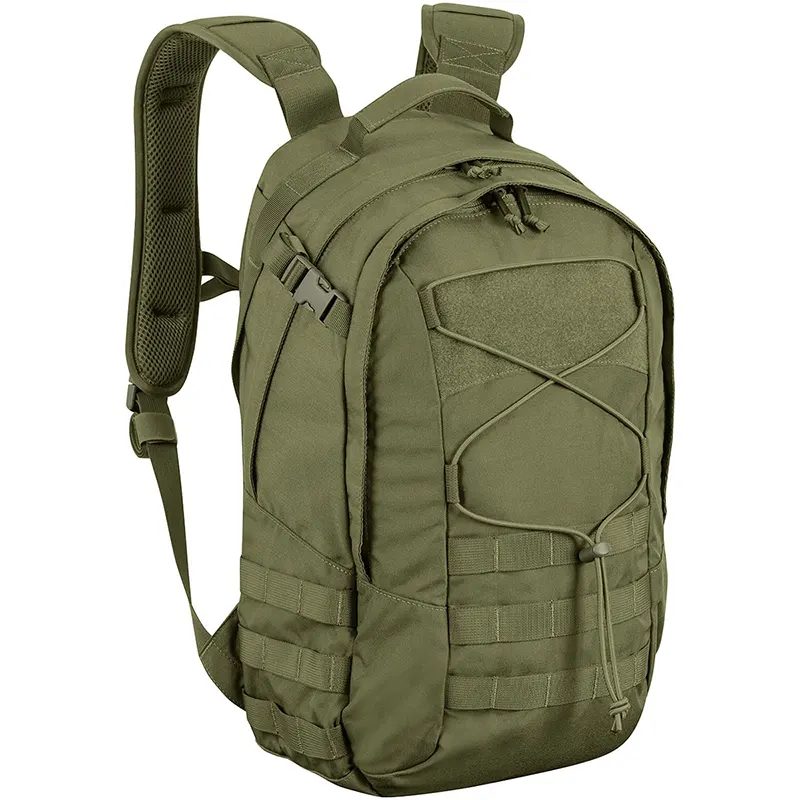Oxford fabric is a versatile, durable material used across industries—from fashion to outdoor gear. This FAQ-style guide dives deep into its properties, uses, and care, providing detailed answers to common questions.
Let’s explore!
1. What is Oxford Fabric?
Oxford fabric is a woven textile known for its distinctive basketweave pattern, created by weaving two threads together over a single thread in the opposite direction.
Traditionally made from cotton, modern variants use nylon, polyester, or blends for added strength.
Key Features:
- Textured, matte finish.
- Lightweight yet durable.
- Resistant to abrasion and tearing.
Originally designed for breathable dress shirts in 19th-century Scotland, it’s now widely used in luggage, footwear, outdoor gear, and yes—tactical equipment like vests and bags, thanks to its ruggedness.
 basket weave pattern
basket weave pattern
2. How is Oxford Fabric Manufactured?
The production process involves:
- Weaving: A plain weave technique with a 2×1 basketweave pattern (two weft threads crossing one warp thread). This creates a tight, flexible structure.
- Coating: Most Oxford fabric is treated with polyurethane (PU) or polyvinyl chloride (PVC) to enhance water resistance.
- Dyeing: Pigments are added during or after weaving. Higher-quality fabrics undergo solution-dyeing for fade resistance.
Specialized variants may include:
- Blended fibers (e.g., nylon-cotton) for softness.
- UV-resistant treatments for outdoor use.
- Fire-retardant coatings for industrial applications.
3. Why is Oxford Fabric Popular for Durable Goods?
Oxford fabric’s rise in industries like outdoor gear and tactical equipment stems from its balance of strength and weight:
- Durability: The tight weave resists snags, punctures, and abrasions. For example, a 600D Oxford fabric backpack can withstand years of rough handling.
- Weather Resistance: PU/PVC coatings repel rain and spills, making it ideal for backpacks, tarps, and protective covers.
- Lightweight: Unlike heavy materials like leather or canvas, it doesn’t add bulk—critical for gear meant to be carried long distances.
- Cost-Effective: Simpler to produce than technical fabrics like Cordura, making it accessible for budget-conscious brands.
Tactical gear manufacturers favor it for pouches and vests because it holds up under stress without sacrificing mobility.


4. What Does “Denier” Mean in Oxford Fabric?
Denier (D) measures the thickness of individual threads in the fabric. A higher denier means thicker, heavier threads.
| Denier Range | Common Uses |
| Low Denier (150D–300D) | Lightweight apparel, liners, hats |
| Mid Denier (600D) | Daypacks, laptop bags, tactical pouches |
| High Denier (1000D–1680D) | Heavy-duty luggage, military gear, industrial equipment |
Tip: Denier alone doesn’t determine strength—weave tightness and coatings matter too!
Most tactical gear uses 600D to 1680D Oxford fabric.
5. Is Oxford Fabric Waterproof?
Oxford fabric is water-resistant, but not fully waterproof. Here’s why:
Coatings: PU or PVC layers block light rain and spills. However, seams and stitching can let water through.
Limitations: Submerging Oxford fabric gear (e.g., in a river) may cause leakage.
For heavy rain, pair it with a waterproof liner or look for welded seams. Some brands laminate the fabric with TPU for enhanced protection.
6. How Does Oxford Fabric Compare to Cordura?
Cordura is a branded nylon fabric known for extreme abrasion resistance. While both are tough:
- Oxford: Lighter, more affordable, smoother texture.
- Cordura: Heavier, better for high-friction areas (e.g., backpack straps).
For budget-friendly durability, Oxford is a winner.
7. Can Oxford Fabric Withstand Extreme Temperatures?
Cold Weather: Performs well in temperatures as low as -30°F (-34°C) without becoming brittle.
Heat Resistance: Handles up to 200°F (93°C) but may degrade with prolonged exposure.
UV Exposure: Untreated fabric can fade or weaken in direct sunlight.
Opt for UV-stabilized variants for outdoor gear.
8. How to Clean and Maintain Oxford Fabric?
Step-by-Step Care:
- Spot Clean: Use a damp cloth and mild detergent for small stains.
- Machine Wash (if safe): Use cold water and a gentle cycle. Avoid bleach.
- Dry: Air-dry or tumble-dry on low heat. High heat can melt coatings.
- Reapply DWR: Use a Durable Water Repellent spray yearly to restore water resistance.
Storage Tip: Keep gear in a cool, dry place to prevent mold.
9. Is Oxford Fabric Eco-Friendly?
Traditional Oxford fabric isn’t sustainable—it’s made from synthetic, non-biodegradable materials. However, innovations include:
- Recycled Materials: Brands like Patagonia use recycled nylon from fishing nets.
- Bio-Based Coatings: PU derived from plants instead of petroleum.
- Certifications: Look for OEKO-TEX or bluesign® labels for eco-conscious options.
Challenge: Recycling coated fabrics remains difficult due to mixed materials.
10. Can Oxford Fabric Be Repaired?
Yes! Here’s how:
- Small Tears: Use tenacious tape or fabric glue for quick fixes.
- Large Damage: Sew with a heavy-duty needle and nylon thread.
- Worn Coatings: Reapply a PU sealant (e.g., Gear Aid ReviveX).
For high-value gear, consider consulting a professional repair service.
11. Does Oxford Fabric Shrink or Fade Over Time?
- Shrinking: Minimal if washed properly (cold water, air-dry).
- Fading: Solution-dyed fabrics resist fading; cheaper dyes may degrade in sunlight.
Tip: Turn the gear inside-out before washing to preserve color.
12. What’s the Lifespan of Oxford Fabric Products?
With proper care:
Light Use (300D): 3–5 years (e.g., casual backpacks).
Heavy Use (600D–1680D): 5–15 years (e.g., tactical vests, luggage).
Factors like UV exposure, frequency of use, and coating quality affect longevity.
13. Is Oxford Fabric Fire-Resistant?
Standard Oxford fabric isn’t fireproof. However, fire-retardant treatments (e.g., Proban®) can be applied for use in firefighter gear or industrial settings
14. Is Oxford Fabric Breathable?
Oxford fabric isn’t very breathable because of its tight weave and synthetic materials like nylon or polyester. Lightweight variants (150D–300D) allow slight airflow, but water-resistant coatings like PU or PVC further reduce ventilation.
This makes it great for tough gear like tactical bags or covers, where durability matters more than airflow. However, it’s not the best choice for breathable clothing.
If you need better ventilation, try mesh-lined designs or natural fabrics like cotton.
15. Can Oxford Fabric Be Used for Clothing?
Yes! Lighter deniers (150D–300D) work well for:
- Outerwear: Windbreakers, rain jackets.
- Workwear: Durable pants, utility shirts.
- Accessories: Caps, gloves.
Its softness and noise-free texture make it preferable over crinkly technical fabrics.
16. How to Identify High-Quality Oxford Fabric?
Weave Consistency: No loose threads or uneven patterns.
Coating Thickness: A smooth, evenly applied PU/PVC layer.
Certifications: ISO 9001 for manufacturing standards.
Brand Reputation: Trusted suppliers like YKK for zippers.
17. How to Choose the Right Oxford Fabric for Your Needs?
Consider:
- Purpose: Daily use vs. extreme conditions.
- Weight: Higher denier = more durability but less flexibility.
- Coating: PU for flexibility, PVC for rigidity.
- Aesthetics: Matte finish for tactical gear, glossy for fashion.
Example: A 600D PU-coated Oxford bag suits hiking, while 1680D PVC-coated fabric works for industrial covers.
18. Can Oxford Fabric Be Custom Printed?
Absolutely! Its smooth surface accepts:
- Screen Printing: Bold logos for promotional tote bags.
- Sublimation: Vibrant, all-over designs for fashion backpacks.
- Embroidery: Tactical gear branding with nylon thread.
Note: Dark fabrics may require laser engraving for contrast.
Final Thoughts
Oxford fabric’s adaptability makes it a favorite for designers and engineers alike. Whether you’re crafting a tactical vest or a stylish tote, understanding its properties ensures you pick the right variant for the job.
Many of our tactical bags and gear use Oxford fabric for its rugged reliability. Want a custom color, denier, or coating?
Contact us to create gear tailored to your mission!


